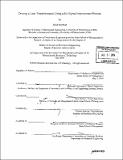| dc.contributor.advisor | Deborah Nightingale and Roy E. Welsch. | en_US |
| dc.contributor.author | Krishnan, Satish, 1974- | en_US |
| dc.contributor.other | Leaders for Manufacturing Program. | en_US |
| dc.date.accessioned | 2006-11-08T16:35:18Z | |
| dc.date.available | 2006-11-08T16:35:18Z | |
| dc.date.copyright | 2004 | en_US |
| dc.date.issued | 2004 | en_US |
| dc.identifier.uri | http://hdl.handle.net/1721.1/34771 | |
| dc.description | Thesis (M.B.A.)--Massachusetts Institute of Technology, Sloan School of Management; and, (S.M.)--Massachusetts Institute of Technology, Dept. of Mechanical Engineering; in conjunction with the Leaders for Manufacturing Program at MIT, 2004. | en_US |
| dc.description | Includes bibliographical references (p. 73-74). | en_US |
| dc.description.abstract | Successive transformations within manufacturing have brought great efficiencies to producers and lower costs to consumers. With the advents of interchangeable parts between 1800 and 1850 in small arms manufacturing (Hounshell, 1984, pp. 3-4), mass production in the early 1900s in automobile manufacturing (Hounshell, 1984, pp. 9-10), and lean production in the early 1950s in automobile manufacturing (Womack, Jones, & Roos, 1990, p. 52), the state of manufacturing has continued to evolve. Each time, the visionaries that catalyzed the transformations were forced to overcome the inertia of the status quo. After convincing stakeholders of the need for change, these change agents: 1. Established a vision for the future 2. Committed resources to attain that vision 3. Studied the root causes for current methods 4. Proposed a new solution 5. Implemented the new solution 6. Quantified the results and sought future improvements. This basic process to implementing change is remarkably simple yet incredibly powerful. By explicitly emphasizing the need for root cause analysis, the process recognizes that improvements will be transient if the root causes of prior problems are not fully understood and resolved. When deploying a lean production system, an understanding of lean principles and tools is necessary but therefore not sufficient. Rather, implementing a lean production system should follow: 1. An analysis mapping the root causes of current production methods back to technical issues and the organization's strategic design, culture, and political landscape. Only by fixing the problems that led to the current production system can a lean transformation be sustained. 2. A detailed plan which achieves a transformation in both the organization | en_US |
| dc.description.abstract | (cont.) production system. | en_US |
| dc.description.statementofresponsibility | by Satish Krishnan. | en_US |
| dc.format.extent | 74 p. | en_US |
| dc.format.extent | 5552165 bytes | |
| dc.format.extent | 5558437 bytes | |
| dc.format.mimetype | application/pdf | |
| dc.format.mimetype | application/pdf | |
| dc.language.iso | eng | en_US |
| dc.publisher | Massachusetts Institute of Technology | en_US |
| dc.rights | M.I.T. theses are protected by copyright. They may be viewed from this source for any purpose, but reproduction or distribution in any format is prohibited without written permission. See provided URL for inquiries about permission. | en_US |
| dc.rights.uri | http://dspace.mit.edu/handle/1721.1/7582 | |
| dc.subject | Sloan School of Management. | en_US |
| dc.subject | Mechanical Engineering. | en_US |
| dc.subject | Leaders for Manufacturing Program. | en_US |
| dc.title | Driving a lean transformation using a six sigma improvement process | en_US |
| dc.type | Thesis | en_US |
| dc.description.degree | S.M. | en_US |
| dc.description.degree | M.B.A. | en_US |
| dc.contributor.department | Leaders for Manufacturing Program at MIT | en_US |
| dc.contributor.department | Massachusetts Institute of Technology. Department of Mechanical Engineering | |
| dc.contributor.department | Sloan School of Management | |
| dc.identifier.oclc | 56715024 | en_US |
